In my pursuit of toolmaking, I don’t want others to come to harm. I use a lot of odd bits and bobs to make things with. Brass and bronze have a special appeal. The problem is that these items can be full of lead. Leaded brass is easy to work and polishes up with ease.
As long as no one looks over your shoulder or cares about the dangers, there are a lot of good reasons for a business to use leaded materials. Since compassion is only allowed in publicly traded companies when it is dictated by law, or demonstrably more profitable, it is just not safe to assume the products we buy are safe.
10$ and free shipping for 8 test swabs is a bargain considering that what you don’t know can make you and your children stupid and irrational. (Free shipping on $25+ orders, so you will have to get a few other items. Getting this marshmallow gun with it will still leave you 2 cents short.)
You take a swab, shake it up, crunch up the little glass containers inside the plastic sleeve, shake it up again with the swab pointed up, to mix the tiny shards of glass, powder and liquid, and then point it down and squeeze juice into the swap.
There is enough juice to drip some of the test fluid on a few objects and then swab with the remainder. This way you can test a few things at once.
I gathered a bunch of stuff I wanted to test and cleaned or polished or sanded a few areas on these surfaces. I also put the stuff that I thought would be safe first on my list to test. Once you have rubbed the swab on grungy or lead, you can not do further testing with it. You can however as long as it is still damp, clean and testing negative, keep checking stuff.
It comes with a couple of cards with lead spots so you can be sure it is working if everything tests out lead free.
The high speed sprayer nozzle, a long discontinued item from Harbor Freight, tested positive. The brass hose connector also discontinued, from Harbor Freight also tested positive, but not strongly.
This is sad, because both of these items are used for gardens, pets, yards and even children. It is also sad, because they would make great ferrules for tools. The little Stanley insert for opening sliding cabinets tested negative as did several other nice brass fittings. The old air hose fitting tested negative so it will someday be a very pretty ferrule.
These three pieces of brass all show red. The one on the left I was planning to use to make a tool today. This is the reason I started the lead testing. Now it is trash. I am not going to use it. The middle piece is a tube from a pen turning kit. Since the user will never touch it, I don’t have a big issue with the lead content.
Since the dust and shavings will be in my work area after I work it, I am going to have to come up with another way to turn pens. Otherwise I will be increasing the ambient lead in my work area, yard and on the products I make. The tube on the far right is a typical brass tube like you can get at a lot of hobby stores. Yes it tested positive. I will not be buying anymore of these.
I pulled off the sleeve on one of the test swabs so you can see the two glass vials inside. Make sure to crunch them up well and mix the ingredients. Note the scarlet stain on the trammel below the vial. Sadly this trammel tested quite positive.
I was worried about the small brass fittings in these pictures but they seem O.K..
The beautiful, functional and well designed trammels that I got from Rockler will never be used again. I really did not want this tool to fail. I just lightly brushed a whisper of the test fluid on the inside flat of the trammel.
The picture does not do justice to the lovely scattering of scarlet that matches with the lead test included with the kit.
This is really sad as this is probably the prettiest tool that I have ever bought. This trammel is perfect apart from the fact that it is laden with lead. I cannot use it, nor will I pass it on to someone else for them to use. I have tested brass fittings on 12 other tools and none of them came close to as high a reading as this trammel. I really liked this trammel set.
I probably would have put a thin coating of epoxy and then hard wax on it and just been careful if it had a low level of lead in it. Foolish of me perhaps, but it really is a nice trammel. This is not just a touch of lead however.
I guess this is another good reason to make your own tools. It is also a good reason to drink Kombucha Tea.
Bob
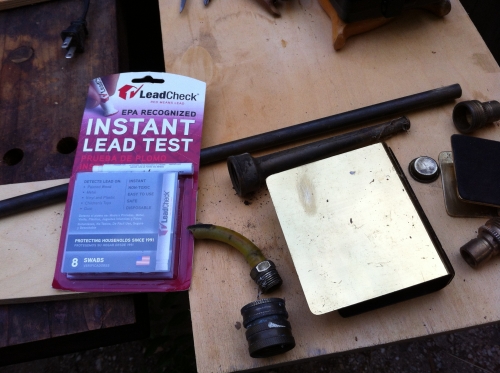

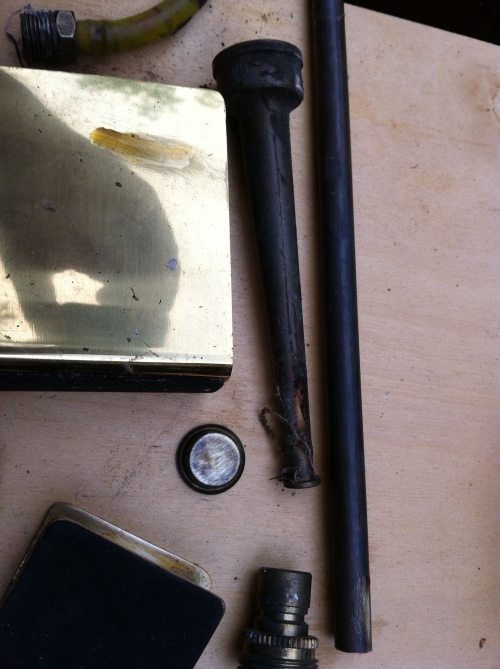
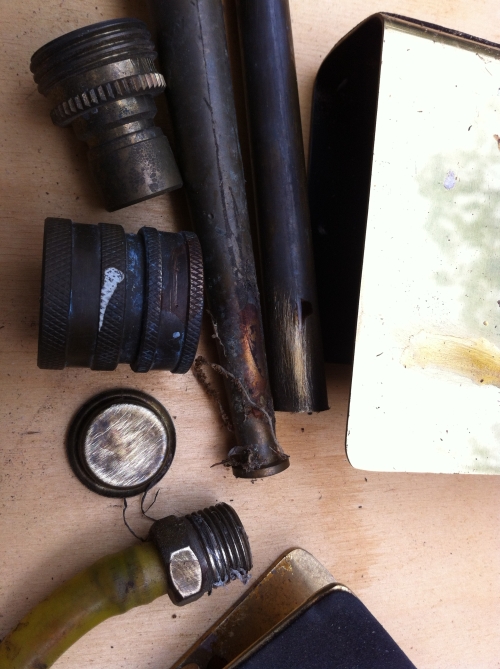
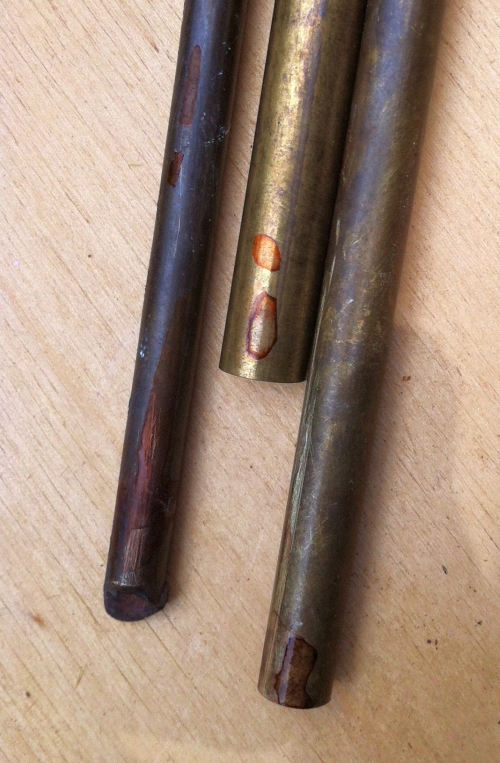

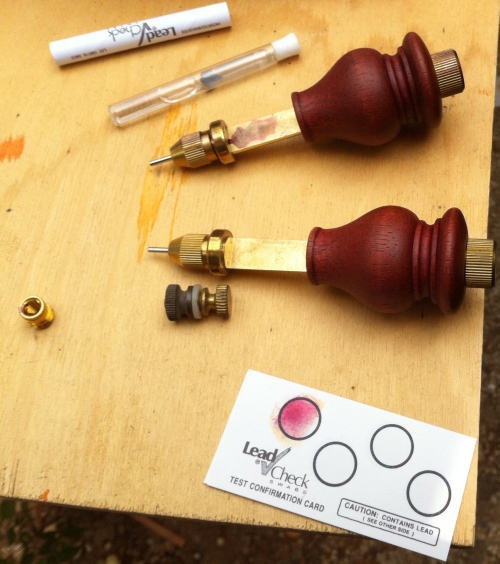
 A page Dedicated to My Writing
A page Dedicated to My Writing
Most brass has lead in it. I think one common alloy that doesn’t is naval brass. I think you’re over-reacting to the lead hazard in those brass tools though. Unless you’re putting them in your mouth, your lead exposure is minimal. A lot of lock keys contain lead as well.
You should take precautions when working the brass however, cutting, filing, etc.
I don’t in fact think I am being careful enough. Someday my items will leave my hands, fall to the side or pass downstream. Pretty things of bronze can hold up even to time while being ready to release their toxins to the unsuspecting. Steel Chainmail as tough as it is does not survive the test of time. Leaded brass can hold on for ages and will always lure the eye of a child. Hands rub eyes, touch lips, food, tables and doorknobs. A simple bauble with rubbing and sweat can elevate risk in areas unpredicted. My filings are hard enough to control, as they bed in corners, but the brass I rub on wood burnishes a polish of bronze where it passes. Gently this can end up in carved spoons, cutting boards, and tables. As it wears and passes, the probability of cancer, stupidity, carelessness, even rage, increases in those it passes to.
I will again quote Wilbur Pan, a solid woodworker, a physician who treats children with cancer, and a rather brilliant blogger.
Wilbur Pan, M.D., Ph.D., a pediatrician allowed me to quote him here:
I can put some numbers on the hazards of lead exposure. It’s not so much for the worker, but for children that they may come into contact with the lead particles that are carried out from the workplace.
In my day job I’m a pediatrician, and so lead toxicity is something I’m very familiar with. At lead levels of 10 micrograms/dL, a 5 year old will start losing IQ points. Doing the calculations for a typical 5 year old’s weight and figuring out the blood volume, that’s only 144 micrograms, or 5 millionths of an ounce of lead that kid has to swallow before his IQ starts to take a hit. Each 5 millionths of an ounce of lead will knock off about 5 IQ points.
This is an additive effect: every additional 5 millionths of an ounce of lead will knock off an additional 5 IQ points. So saying that you’re not going to worry about the additional small level of lead that you may be exposed to doesn’t make sense. It would have to be an incredibly small amount of lead to come in under that 144 microgram level. And again, this is an additive effect. Even if you only brought home 50 micrograms of lead dust on your clothes from a session at the gun range, after three trips, you’ve hit that 144 microgram level.
Other things associated with lead exposure: hyperactivity, failure to graduate high school, reading disability, delinquency, and hearing deficits. After 360 micrograms of lead ingestion in that 5 year old kid, anemia starts to kick in.
The usual exposure source for lead for kids is lead paint. But as the old housing stock either gets torn down for new construction, or increased awareness of lead paint has kicked in and more people are painting over or decontaminating their old houses, it seems that these days if kids are going to pick up lead, it’s from contaminated dirt. That would include dirt contaminated with lead particles carried away from the workplace, or a gun range.
I cannot say what will happen with the things I make after they leave my hands. It is more than my life is worth for me to pass misery on to those that follow me, by actions that can with a little inconvenience and cost be entirely avoided.
Bob
Bob, is there generally any worry about lead in the steel or wood in old tools? I’m thinking old wooden planes, saws, etc.
Thanks
Hi, Shaun,
The first bit of lathe work that I did, was in a machinists class at TSTC. It was TSTI back then, so I am dating myself. We made a lovely nutcracker out of leaded steel. Leaded steel is easy to work, relatively corrosion resistant and it can be made nice and shiny. It is not a tool steel, but it is a steel that was preferred for general machine work. Some engine cylinder designs used to specify this steel. Often axles, shafts and gears used this steel.
It will rust however, and that rust will have lead in it. It is a touch weaker, since it has tiny lead inclusions. The content is comparable to a lot of modern brass, I think 0.11 to 0.20 percent but since it can corrode and oxidize much more easily the potential for lead release can be quite high, If you consider that a millionth of an ounce of lead is worth one IQ point for a five year old, then one ounce of this rust can be worth 1000 to 2000 points of IQ. Birth defects, cancer and organ failures just add to the value of this.
Modern free machining brass contains 2.5 to 3.7 percent lead so it is quite high compared to steel. There are even variations of brass and bronze being made that go from 7 to 30 percent lead. These alloys are prized for their thermal properties and their ability to maintain lubricity in rough environments. Brass and bronze are less prone to corrosion, so in some way they can be considered less risky than steel, lead content for lead content.
Corrosion however is not the only way that lead can be freed from the alloy containing it. Lead containing metals will ‘sweat’ lead. Heat, stress and time can cause lead to migrate to the surface of such metals. This is why lead reduces corrosion and is useful as a bearing. The result of lead sweating out of metals is however what makes using these metals so dangerous. We don’t actually know at a given time what level of lead is so it is hard to judge the risks.
It is also easy to consider lead safe enough to work with, lead by itself does not absorb readily through skin. However fine particles of lead, and some easily formed chemical compounds with lead in them will readily absorb through skin.
Since lead would ruin tool steel, for the most part I would not worry. But large adjustment screws and the like might be worth testing. In general I am more concerned with the Japanning on old tools than the steel.
Bob
Hi Bob;
I’m enjoying your new blog posts again… well done!
It doesn’t surprise me at all that you finally got around to this one….
Keep up the good work;
Skip
Hi Bob,
I’ve been refinishing a couple of old planes and sandblasting or using a wire wheel to remove the japanning. What do you believe the lead content or exposure might be?
I have no way of knowing, all I can say is keep clean, contain the waste carefully, and wear the best air filter you can. Not knowing is sadly a big part of this issue. I personally enjoy kombucha and wakame quite a bit, so I am all about the internal bioremediation. might help.
Kombucha probably won’t hurt, unless it was brewed in the wrong container.
Bob
I came across this today, over a decade after you published it. You have presented some chilling facts on the risks of lead poisoning from tools that we think are going to improve our lives and those of others.
Our natural human tendency to continue what we do, because of “utility”, makes us resistant to change what we are doing, or the tools and materials we are using. We can be told about lead in brass or Babbitt metal bearings etc., or even Japanning, but we will just look away and pretend it must be untrue.
Lead is one of the most toxic substances ever dug up and used. This has been well understood from ancient times. Lead is the most studied element.
So we can not pretend we were never told about the risks.
I’ll be drawing the attention of others to your excellent writing on this subject.
Many thanks.